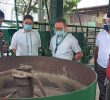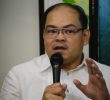Pacific Strategies & Assessments, a leading Asia-based business risk consultancy, produces a weekly report for its clients in the Philippines. Its reports stand out for their intelligent, informed and candid assessment of Philippine business and politics. PSA, which operates in Manila and other key Asian cities, provides business intelligence, investigations, public affairs, security, and crisis management services.
In its report this week, PSA takes a look at these issues:
1) the �state of decay� at Napocor
2) the similarities betwen Fidel V. Ramos�s Pirma initiative and Arroyo�s Charter-change campaign
3) the whitewashing of the Mayuga report
4) how the government is scaring off investors
5) how the strengthening peso is actually bad for many Filipino businesses
6) the Philippine tourism boom
Napocor: A State of Decay
The government a few years ago announced a hopeful plan to privatize the National Power Corporation (Napocor), a gargantuan government-owned firm notorious for huge debts incurred through mismanagement and corruption. Particularly, the firm�s debts stem from numerous controversial contracts that lopsidedly favor power producers that charge expensively for their output and several power projects that remain idle because of muddled planning.
It should be noted that these now controversial contracts were driven by necessity during the major power crisis of the early 1990�s when there was a desperate need for attractive contract provisions to entice foreign investors into an investment market where contracts often lack the sanctity of law over time and are often overturned on political whim. Without payment and power usage guarantees no one would have come to the Philippines rescue at a time of dire need.
Equally frustrating, the government has disingenuously drafted a vaunted but totally unrealistic blueprint of selling Napocor assets to pay off its debts and reduce the fiscal deficit. The business community has now heavily criticized Napocor officials when they announced last week that they had sold about 10% of Napocor assets, a far cry from the targeted 70% that was promised back at the end of 2004. Congress later discovered that the officials had hidden the real figures � only 3% of Napocor�s assets have been sold.
What the Philippine government is never honest about when it pontificates about the sale of Napocor and its potential cash windfall for debt servicing is the reality that utility fees are heavily subsidized through price controls to appease the majority of Filipinos who are poor by every statistical definition. Due to price controls it is impossible for Napocor to make a legitimate profit and it would be the same for anyone stupid enough to purchase significant parts of Napocor.
The inability to sell Napocor spells even more trouble for the Philippine economy and its taxpayers. Napocor will continue to borrow huge amounts of money guaranteed by the government, meaning that taxpayers ultimately shoulder the burden. Last year, Napocor borrowed US$800 million; this year it plans to take on another US$700 million in debt. Napocor�s total debt is now equal to a third of the Philippines� national debt, having reached US$9.6 billion in mid-2005 from only US$6.2 million five years ago. Napocor needs this money to service existing debt, keep its bloated bureaucracy afloat, and keep pace with payments for pricey energy purchases from independent power producers.
Many cynics believe that Napocor officials have been dragging their feet in the privatization drive because they want to retain their lucrative jobs. Senior officials apparently receive millions of pesos in kickbacks and commissions from fuel importers and others. They also have heavy retirement packages, with each allegedly receiving a little over US$2 million in one-time payments. Soon after retiring, many are rehired as consultants to stay on the payroll. Moreover, officials use their influence to have Napocor sign contracts with private companies that they own or operate. These realities certainly play poorly in the minds of would be Napocor buyers.
Corruption at Napocor has a serious effect on an already debt-heavy government that will likely have to borrow even more overseas to service existing debt. As it does, there will continue to be less money left over for education, health care, and road repairs. President Gloria Macapagal Arroyo has the authority to make changes, but her continued focus on political survival makes meaningful power sector improvements difficult to imagine.
Then and Now: Similar Initiatives
The �people�s initiative� that the Arroyo government is currently engineering to change the Constitution is hardly an original idea. The concept first surfaced with former president Fidel Ramos, who despite recent conflicts with President Arroyo echoes her call for change to a parliamentary system. In 1997, then President Ramos waged his own campaign to change the Constitution to allow him to stand for president for a second term. The initiative supporting Ramos� plans for reelection, the People�s Initiative for Reform, Modernization and Action (Pirma), was wildly successful in obtaining the required number of signatures, having roughly two million votes over the required number of 4.2 million to allow the petition. Still, this initiative failed because of questions about its legitimacy, steadfast resistance from the opposition, and objections from the Supreme Court.
Congressional party mates were said to have influenced their constituents to add their signatures to the 1997 campaign. Jose Almonte, one of Ramos� trusted advisers, admitted that he was the brains behind the Pirma operation. Opposition groups quickly called the initiative self-serving to help ruin its credibility with voters. Two days before the Supreme Court was scheduled to deliver its ruling, opposition supporters of Joseph Estrada (who even then was touted as Ramos� most likely successor as president), former president Cory Aquino, and then-influential Manila archbishop Cardinal Jaime Sin trooped with thousands of followers to Manila�s Luneta Park to protest. The Supreme Court, headed by Estrada�s former lawyer Andres Narvasa, sank Ramos� initiative by a vote of 8 to 6, saying the people�s initiative law only applied to local exercises and not serious national matters. The undeterred Pirma folk approached the Commission on Elections to have their signatures verified anyway, but Comelec officials refused, citing the Supreme Court decision.
Arroyo�s version of Pirma appears to be headed in a similar direction. The Arroyo initiative is now receiving some flak from detractors who accuse the president of attempting to extend her stay in office to avoid investigations into allegations she used government funds to cheat in the 2004 elections. Opposition groups have already asked various regional trial courts to stop verifying signatures from the latest people�s initiative campaign. Nine years after the failure of Pirma, Congress has still not finalized enabling legislation to assure that the Arroyo initiative would breeze through the Supreme Court.
But all is not lost for Arroyo. She has wisely populated the ranks of the Supreme Court with her people, including the current Chief Justice Artemio Panganiban, who is said to be very friendly towards the current administration, having been part of the Supreme Court that installed Arroyo into power some five years ago. Panganiban and Reynato Puno, another senior Supreme Court Justice, actually ruled in favor of the Pirma campaign in 1997, saying that while the law was poorly created, there was no such thing as an insufficient and incomplete law. The current Supreme Court has acted favorably for Arroyo in recent years, conveniently holding back its rulings on controversial executive orders such as EO 464, which prohibits government officials from appearing in investigations without the president�s consent. A favorable Supreme Court ruling would be unsurprising at this point. Moreover, it would only underscore the malleable nature of the Philippine judiciary.
An emerging battle on this issue can be expected. The opposition will resort to chicanery just like the Arroyo crowd with the end result being more tepid rallies, protests, and publicized media affairs over the near to medium term.
Another Whitewash
Last week, President Gloria Macapagal Arroyo finally approved the release of the Mayuga Report, a document containing the findings of a Philippine armed forces investigation into allegations that several senior military officers had helped rig the 2004 national elections. The public has wildly anticipated the release of this report, with its promise of identifying the exact complicity of several military generals implicated in a series of recorded cellular telephone conversations between a former elections commissioner and several individuals (including a woman who sounded suspiciously like Arroyo). Administration representatives proudly said the report was fair and very intensive, adding that its recommendations could be used to help formulate measures that would protect the military from further political manipulation.
The unnecessary government sugarcoating merely highlighted the fact that the report failed to answer the most urgent questions surrounding the issue of military participation in elections cheating. The report essentially cleared the generals from any wrongdoing � it said the investigating body had failed to find any evidence of their direct involvement. It seems that from the very start, the activity avoided a direct investigation on the generals, preferring instead to take an informal �fact- finding� approach. As a dismal alternative, officials explained that the report had identified other minor officers who were involved in the cheating, but the same officials refused to reveal their identities to protect government investigators from serious danger. Only a portion of the report was actually available to the public, according to the officials. Critics dismissed the report as being a case of �too little, too late�. Given the situation, the Arroyo camp probably understood that the lightweight report was going to receive a lot of flak from frustrated observers. They timed the report�s release in the middle of Holy Week, hoping that the distractions brought by the Lenten solemnities would divert public attention from the issue. They expected the issue to be safely delegated as yesterday�s news by the time Easter Sunday came around.
The whitewash was an expected move from the Arroyo camp, which has been known to protect its loyal servants. It is widely believed that the administration helped former elections commissioner Virgilio Garcillano hide in local and overseas destinations for several months while authorities were calling for his appearance in investigative hearings to shed light on the elections cheating issue. Nor has the Arroyo administration lifted a finger when it was discovered recently that Garcillano had traveled abroad on a fake passport. Other henchman, Department of Agriculture official Jocelyn Bolante and former Agriculture Secretary Cito Lorenzo who are widely suspected of diverting government fertilizer funds to Arroyo�s 2004 election campaign, have fled to the United States and vanished from public view, presumably with help from the same Arroyo political crowd. The fact that the report was only released to the public months after its submission to the executive department raised rumors that the administration had sanitized the report to protect the pro-administration generals, two who were given promotions soon after the 2004 elections and one is expected tobe elevated to the position of Armed Forces Chief of Staff.
The Mayuga report�s release has not answered any of the basic questions raised by the issue. In the Philippines, the military has become increasingly politicized in step with the growing symbiosis between politicians and senior military officials. Often, members of the two groups help each other to carry out their illicit motives at the nation�s expense. As it is, the lack of a genuine investigation into the problems of the military and the country�s election process signifies that no improvements are in sight for these areas. The issue still has the possibility of becoming more fodder for local political theater after senators announced they would continue the investigations on the implicated generals. As the political opposition sets its sights on the generals, the ruling administration is expected to come up with a frantic defense, knowing that another drawn out political scandal is the last thing the tired Mrs. Arroyo wants at this point.
Scaring Off Investors
The Philippines seems to be missing out on resurgent investor interest in Asia. Recent data shows that foreign direct investments have slipped to US$200 million per month in 2006 from almost US$700 million a month two years ago.
While foreign direct investments seem similar to last year, these contracts were finalized before Arroyo�s political troubles began in earnest.
More important brick-and-mortar investments in the country have slipped since 2004. The Philippines� investment environment fails to measure up to Asian destinations such as China and Vietnam. To operate in the Philippines, entrepreneurs have to deal with a laborious business permit system and government employees who sit on the paperwork until they are bribed. The nation�s poor infrastructure, inconsistent judicial review, and growing labor costs are major turnoffs to locating in the Philippines. Investors also hesitate to bring their businesses into the Philippines because of its political instability; they understand that they would be stuck here and suffer losses should local conditions deteriorate. The problem is still politics, which is turning off foreign investors who park their money in the country long term.
Conversely, foreign portfolio investments seem to be rising. With its host of problems, the Philippine government is forced to offer a higher premium on its borrowings, providing interest rates of 8% or higher. These conditions prove irresistible to seasoned investors, who can ably play along to the volatile movements of the country�s unstable stocks and bonds market. They understand that they will make a killing as long as the country waddles along in making its debt payments.
Arroyo continues to brag that institutional investment is proof of her successful economic fundamentals. This is the farthest thing from the truth � it is in fact her failure to address economic deficiencies that drive bond yields up to levels that attract more institutional investors. Nor can Mrs. Arroyo claim any credit for a recent climb on the local stock market. Strong local companies such as SM, PLDT, and Globe prosper because of more consumer spending from increased remittances from overseas Filipino workers (OFW�s). OFW remittances not Arroyo have become the ultimate but real heroes of the Makati stock exchange. More telling about the sad Philippine economy is the fact OFWs are essentially people who cannot find gainful work in the Philippines and relocate to Hong Kong, the United States, and the Middle East to find jobs with comparatively much higher salaries.
The Bad Side to the Good News
Administration economists have continually presented the peso�s appreciation as a positive indicator, boasting that it in gaining roughly 10% on the US dollar by dropping from PhP56 to PhP51 within several months, it has been Asia�s strongest currency for quite some time now. The peso drew strength from increased OFW remittances, steady inflows from foreign portfolio investors, and the recent weakening of the dollar against a whole basket of currencies. However, Philippine exporters, who already suffer from slim profit margins, are feeling the pain. A sudden 10% drop in the value of the dollar makes their products look more expensive to clients overseas.
Industry representatives say they are threatened potentially to lose 2% of an expected 10% growth in total exports value this year because of the sudden peso value hike. This translates to roughly US$823 million in lost export revenue for the year, despite rising global demand for electronics that started in 2005. Analysts say that many small entrepreneurs have started rejecting export orders on fears that they would lose money. Many of these company earnings projections have been ruined by the major change in the peso.
Clearly the industry needs help. They urged the government to streamline export regulations and help with low-interest loans, improved technology and production methods, and better support infrastructure such as roads and ports. Given the government�s track record of service, they shouldn�t hold their breath.
Tourism Boom
The Department of Tourism (DOT) last week announced that a record 420,375 foreign tourists arrived in the Philippines for the first quarter of 2006, a 17% rise from the same period last year. South Koreans led the country�s inbound tourists, making up 21.6% of total arrivals as they become the world�s latest tourism superpower. In January this year, the Philippines and South Korea signed a memorandum of agreement (MOU) to promote tourism by promoting leisure and business travel, as well as study tours and cultural exchanges. Notably, rapid development in South Korea is fast transforming the country into a leisure society. Seoul says that Filipino hospitality and proximity to South Korea were the two main reasons why South Koreans enjoy traveling to the Philippines. The huge numbers of South Korean students, Christian missionaries, and retailers in the country have led to the mushrooming of various establishments specifically catering to South Koreans, which in turn appears to have likewise contributed to the huge influx of South Korean tourists in the Philippines. Better year-round weather and the large number of reasonably priced golf courses in the Philippines probably don�t hurt, either.
Americans followed the Koreans by making up 19.9% of inbound arrivals, and Japanese with 15.5%. Mainland Chinese came in fifth with 5.53%, but surpassed all others in terms of growth after registering a 162.9% rise from the previous year. The DOT hopes the country will surpass its target of three million inbound tourists this year, after last year�s record two million foreign tourists.
The Philippines is poised to reap the fruits of its so-called specific-market approach, whereby tourism marketing is focused on Japanese, South Koreans, and Chinese, as well as Filipinos in North America. However, the Philippines� weak overall tourism infrastructure will likely keep the country far behind neighbors Malaysia and Thailand, each of which hosts more than 10 million tourists a year. Interestingly, despite two Bali bombings and several other deadly terrorist attacks, Indonesia�s inbound average number of tourists is more than double the Philippines at five million per year. It seems tourists are more turned off by inefficient and poor service than threats of terror attacks.










